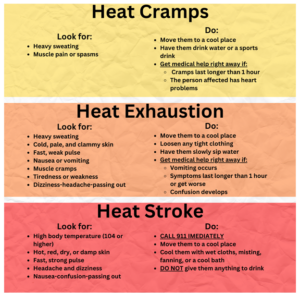Extreme heat is coming to the Pacific Northwest. Prepare now.
By AmeriCorps Employee Stephanie Schulden

As the climate crisis continues, extreme heat in the Pacific Northwest is becoming more common – and more intense. The cause of more fatalities than any other natural disaster in the country, the Pacific Northwest has seen an increase in days over 90° F (32° C) in recent years and some scientists project it is getting worse.
Residents need to prepare each year for heat waves and extreme heat by updating emergency kits, making a plan, and learning how to recognize and treat heat illnesses.
In addition to the American Red Cross-advised emergency kit items, it is recommended that everyone include electrolyte drinks such as sports drinks (powdered or liquid form), sunscreen, and wide-brimmed hats. Additional items include instant ice packs, clean rags that can be placed in cool water, and portable ice chests or coolers. Battery-operated thermometers also allow you to monitor household temperatures and make informed decisions. Individuals with health concerns should discuss extreme heat preparation plans with their doctors.
When you are making your disaster response plan with your household, remember to plan for power outages during an extreme heat event. If you do not have air conditioning, identify places you can go during the hottest time of the day. Places to consider include schools, libraries, movie theaters, and stores or malls. Without air conditioning, there are still ways to can keep you, your pets, and your home cooler during extreme heat.
Cool your home:
- Use a battery powered thermometer to monitor room temperature
- Seal any door or window leaks
- Hang up thick or blackout curtains to reduce sunlight
Cool yourself:
- Take cool baths or showers
- Use cloths damp with cool water on the back of your neck and or inner wrists
- Use a fan
- Running a fan in a room hotter than 90° F will not prevent heat illness and can be dangerous.
- Consider making a swamp cooler or flowing air over ice for spot cooling
- This may improve comfort but will not prevent heat illness. Continue monitoring household temperatures and evacuate to a cooling shelter or air conditioned space as necessary.
It is also important to recognize the signs of heat illness. Visit www.redcross.org/heat for more information and download our mobile Emergency app from the Apple or Google Play stores.

If you have air conditioning in your home, but are concerned about additional electricity costs during extreme heat, there are resources available. Check out PGE’s Income-Qualified Bill Discount program here and Pacific Power’s Low-Income Discount program here.
###